"We are what we repeatedly do. Excellence, then, is not an act, but a habit." --Aristotle
Address any questions or comments regarding this newsletter to the individual authors listed after each article or to its editor, Rick Weinzierl, 217-333-6651, weinzier@illinois.edu. To receive e-mail notification of new postings of this newsletter, call or write the same number or address.
In This Issue:
Upcoming Programs (for beginning and established growers)
Regional Reports (from southern and western Illinois)
Vegetable Production and Pest Management (armyworms ... and incorrect names)
Local Foods Issues (webinars on organic certification)
Upcoming Programs
Check the Illinois SARE calendar for a full list of programs and links for registration.
http://illinoissare.org/ and http://illinoissare.org/calendar.php
Also see the University of Illinois Extension Local Food Systems and Small Farms Team's web site at:
http://web.extension.illinois.edu/smallfarm/ and their calendar of events at http://web.extension.illinois.edu/units/calendar.cfm?UnitID=629.
- Meet The Buyer/Meet The Farmer & Overview Of Micro-Food Hub, September 30, 2014. 2:00-3:30 p.m., Champaign County Farm Bureau, 801 N. Country Fair Drive, Champaign, IL. RSVP by September 28 to (217) 352-5235. Farmers wishing to meet retail grocery store, catering, restaurants and foodservice buyers are invited to attend. Program will include preliminary details of the new Micro-Food Hub located in Rantoul, IL.
- Farmer Grant Writing Workshop, October 1, 2014. 6:00 - 9:00 p.m., University of Illinois Extension. Pre-register at http://web.extension.illinois.edu/lms. For more information, contact Deborah Cavanaugh-Grant (cvnghgrn@illinois.edu) or at 217-782-4617.
- Fruit and Vegetable Farmer Cooperative, October 14, 2014. 7:00 p.m., Rantoul Business Center, 601 S. Century Boulevard, Rantoul, IL. RSVP by October 13 to (217) 352-5235. The Illinois Farm Bureau, Champaign County Farm Bureau, and the Village of Rantoul invite area farmers to a fruit and vegetable cooperative meeting. This is a preliminary meeting with plans of forming a fruit and vegetable cooperative for East Central Illinois.
- 2014 Local and Regional Food Summit, November 13, 2014. 9:00 - 5:00 p.m., Heartland Community College, Astroth Community Education Center, 1500 West Raab Road, Normal, IL. Hosted by the Illinois Farm Bureau, Illinois Department of Agriculture and Heartland Community College. Conference registration fee is $20 per participant and includes all conference materials, lunch, and breaks. Register at http://www.ilfb.org/ifb-news-and-events/conferences-events/2014-local-and-regional-food-summit.aspx. Speakers will include industries such as retail grocery, foodservice distribution, university foodservice, food hub, energy alternatives, specialty crops, meat processing, dairy, value-added products, community supported agriculture and more. Register in advance; space is limited. A special Meet the Farmer/Meet the Buyer event for farmers and buyers will take place between 3:15 pm and 5:00 pm for farmers attending the Summit.
- Mark your calendars ... for the Illinois Specialty Crops, Agritourism, and Organics Conference, January 7-9, 2015, at the Crowne Plaza Hotel and Convention Center, Springfield, IL.
Regional Reports
In southern Illinois ... Well it definitely feels like fall now in southern Illinois from temperatures last Tuesday around 90 end-of-the-week highs struggling to reach 70. So far, the lowest predicted temperatures are around the mid-40s. These cool temperatures have high tunnel sides starting to roll up (closed) for some with late summer/fall crops especially on some of the very cloudy days. Also, this has drastically slowed the development of many late plantings of summer crops such as sweet corn, tomatoes, and melons.
Apple harvest is well underway, and the season is looking good with some many growers getting well into Jonathan apples among others. Pumpkin harvest is starting on many local farms, and over all this year if you were managing pests (especially insects and diseases) it was a very good year for pumpkins in southern Illinois. Quality and yields are looking very good. Timely rains and modest temperatures were very beneficial - greatly different than the previous 2 years.
Thanks to everyone who attended the 2014 Pumpkin Field Day at the Ewing Demonstration Center! We had about 100 in attendance from all across the state and the region.
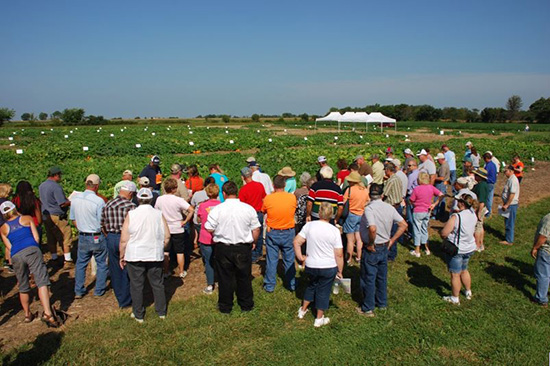
Kate Kammler, Horticulture Specialist, University of Missouri Extension, speaking about pumpkin variety selection at the 2014 Pumpkin Field Day. Pictured in the background are demonstration plots featuring 54 varieties of all shapes, sizes, and colors. (Photo: Laurie George)
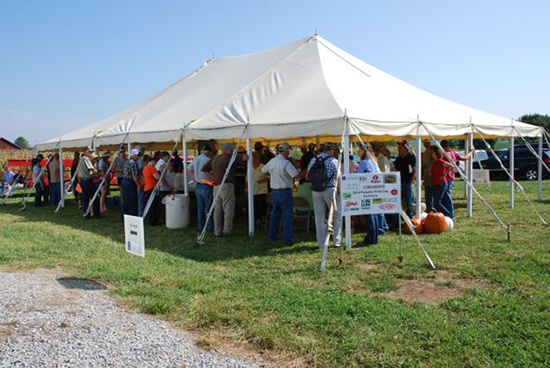
Pumpkin growers and industry representatives gathering for the 2014 Pumpkin Field Day in the registration/vendor tent. (Photo: Laurie George)
Nathan Johanning (618-939-3434; njohann@illinois.edu)
From western Illinois ... 12.35" of rain since August 1. If I were a rice farmer, I'd be smiling from ear to ear! And while the first of these rains was very welcome, I'm wishing I could find the faucet now and turn it off. All the moisture has really caused havoc with the leaf disease situation in many crops (to say nothing of trying to harvest in the mud). But there are always two sides to each story, and with the excess rains the good news is that we are recharging subsoil moisture, which was about nonexistent in this part of the state. Ponds are full. And the irrigation pump hasn't seen much activity.
The pumpkin crop is a good one, with some reporting even better than that. However, one local grower has reported that he is beginning to find rotting pumpkins in his field. This particular grower has had heavy rains during the entire summer, with standing water on a number of occasions in his patch. I don't know which fruit rot pathogen is responsible, but the past few days' rainfall certainly didn't help the situation. The situation is most likely very limited and is mainly due to poor drainage and excess rainfall.
Because of the rains the past 5 weeks, many disease organisms have flourished. Outside tomatoes that haven't been protected with a regular fungicide program are in various stages of death, with from half to all the leaves necrotic. For those growers who still have onions to harvest, the excess rains aren't helping them either.
Sweet corn growers are reporting heavy infestations of corn earworm in late harvests, and the same insect can be found in some untreated tomato and pepper fruits. I've noted and have heard other growers mention the lack of cucumber beetles this year - very little if any noticeable injury to pumpkins and other cucurbits.
The cool and cloudy weather is going to be slowing crop maturity. But this is the time of year when sales of many of these crops are wavering anyway ... for tomato, pepper, melons, okra, squash, etc.
The local honey crisp apple crop is just starting to be picked, and it's a good one. Unfortunately there just aren't enough of them.
The heat of August and the first part of September caused many to delay seeding of fall greens due to poor germination. Now that cooler (in my opinion COLD) weather has arrived, take advantage and get that fall crop started. Low tunnels and/or high tunnels allow extension of fall harvests. Some crops, with protection from the desiccating winter winds can survive all winter, while others will eventually succumb to the cold, even in a semi protected environment of a tunnel. The important thing to remember is to get the crop to harvestable size before sunlight hours diminish to the point of little or no growth occurring. That is usually when sunlight hours decline to about 10 per day. Both the hours of sunlight as well as the intensity of light is diminished enough that plants just can't produce growth. You can find out what day that occurs on in your area (and do some backward calculations) at http://aa.usno.navy.mil/data/docs/Dur_OneYear.php.
I'm not sure how many others might be affected in this manner, but all the rainfall in Aug. and Sept. has taken a toll on our plasticulture system. The soil was somewhat loose after making raised beds the end of July for our strawberries. And while there is a slight slope, it isn't more than 1-2%, but a number of heavy rains accompanied by half the soil covered with plastic concentrated water and caused soil movement from the plastic. To keep the plastic from being removed by winds, I believe our only solution is to place sandbags on the edges of the plastic. Moving the soil that has accumulated at the end of the row back on the plastic is temporary at best, as the next heavy rain will move it again.
Mike Roegge (217-223-8380; roeggem@illinois.edu)
Vegetable Production and Pest Management
Fall Armyworms in Southern Illinois
Over the last 2 weeks we've gotten lots of reports of fall armyworm damage to turf and grass pastures in southern Illinois. I'm sure some reports of corn earworm damage to sweet corn, peppers, and tomatoes may have in fact resulted from infestations of this insect too. Fall armyworm - an insect that migrates into the region as a moth in summer and fall - is different than "true" armyworm that more often causes damage to corn and other grasses in the spring. And for the record, there's even more confusion where certain regional names have persisted for generations. For example, forest tent caterpillar was misnamed as armyworm by residents in southern states in the mid-1800s. One of my students from Tennessee brought me a photo of forest tent caterpillar and passed along to me the fact that residents there had called it armyworm when infestations were observed earlier this year. For the record, here are illustrations of each of these insects.
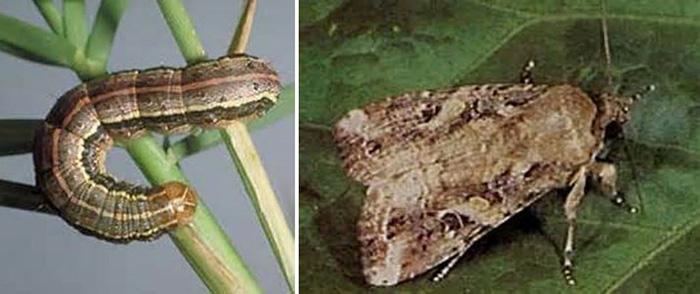
Fall armyworm larvae (left) and adult (right). (Photos from Texas A & M University and USDA
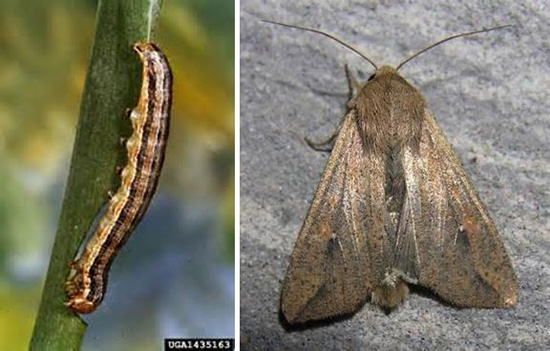
True armyworm larva (left) and adult (right). (Photos from University of Georgia and Kansas State University)
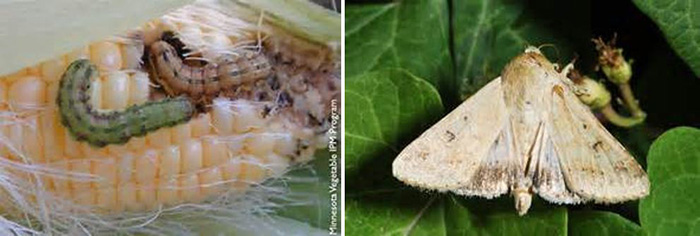
Corn earworm larvae (left) and adult (right). (Photos from University of Minnesota and University of Kentucky)
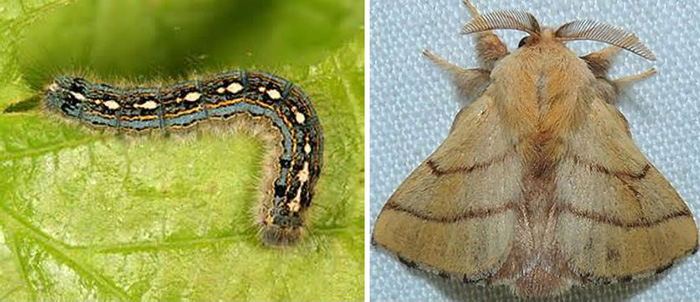
Forest tent caterpillar larva (left) and adult (right). (Photos from bugguide.net)
Rick Weinzierl (217-244-2126; weinzier@illinois.edu)
Local Foods Issues
Webinars on Organic Certification
ATTRA has three new archived webinars on its website that do a very good job of making the organic certification process easier to get a handle on. Access to these webinars is free.
Two of the webinars -- Organic Certification Basics and Examining the Organic System Plan -- were produced in conjunction with Texas Department of Agriculture officials and producers, but the information is transferable to anywhere in the country. The third, Promoting High Quality Conservation on Organic Farms, explores the ways that NRCS conservation practices can help producers obtain and keep certified organic status.
These webinars are available at https://attra.ncat.org/video/.
Deborah Cavanaugh-Grant (217-782-4617; cvnghgrn@illinois.edu)
University of Illinois Extension Specialists in Fruit and Vegetable Production & Pest Management
Extension Educators – Local Food Systems and Small Farms |
||
Bronwyn Aly, Gallatin, Hamilton, Hardin, Pope, Saline, and White counties |
618-382-2662 |
|
Katie Bell, Franklin, Jackson, Perry, Randolph, & Williamson counties |
618-687-1727 |
|
Sarah Farley, Lake & McHenry counties |
847-223-8627 |
|
Nick Frillman, Woodford, Livingston, & McLean counties |
309-663-8306 |
|
Laurie George, Bond, Clinton, Jefferson, Marion, & Washington counties |
618-548-1446 |
|
Zachary Grant, Cook County | 708-679-6889 | |
Doug Gucker, DeWitt, Macon, and Piatt counties |
217-877-6042 |
|
Erin Harper, Champaign, Ford, Iroquois, and Vermillion counties |
217-333-7672 |
|
Grace Margherio, Jackie Joyner-Kersee Center, St. Clair County |
217-244-3547 |
|
Grant McCarty, Jo Daviess, Stephenson, and Winnebago counties |
815-235-4125 |
|
Katie Parker, Adams, Brown, Hancock, Pike and Schuyler counties |
217-223-8380 |
|
Kathryn Pereira, Cook County |
773-233-2900 |
|
James Theuri, Grundy, Kankakee, and Will counties |
815-933-8337 |
|
Extension Educators – Horticulture |
||
Chris Enroth, Henderson, Knox, McDonough, and Warren counties |
309-837-3939 |
|
Richard Hentschel, DuPage, Kane, and Kendall counties |
630-584-6166 |
|
Andrew Holsinger, Christian, Jersey, Macoupin, & Montgomery counties |
217-532-3941 |
|
Extension Educators - Commercial Agriculture |
||
Elizabeth Wahle, Fruit & Vegetable Production |
618-344-4230 |
|
Nathan Johanning, Madison, Monroe & St. Clair counties |
618-939-3434 |
|
Campus-based Extension Specialists |
||
Kacie Athey, Entomology |
217-244-9916 |
|
Mohammad Babadoost, Plant Pathology |
217-333-1523 |
|